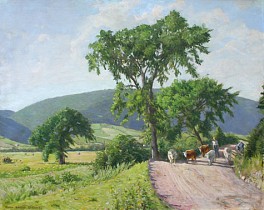BIOGRAPHY

1872-1968
HELEN SAVIER DuMOND
(1872-1968)
In 1872, Portland, Oregon remained a frontier town, inhabited by a growing population of smugglers, brothel owners, laborers, and merchants anxious to profit from the burgeoning timber trade. Born into the city’s emergent upper class, Helen Savier Dumond grew up sheltered from the cacophony of the West. When she reached her late teens, Helen Dumond left Portland to study at the newly-established Art Students League in New York.
At the time of her arrival, the Art Students League was an unstable institution, plagued by defections and pedagogical disputes among the school’s leaders. In the late 1890s, Helen Dumond temporarily separated from the League to study in Paris at the Ecole des Beaux Arts with Raphael Collin and Luc Olivier Merson. Her painting improved and she earned a place at the Paris Salon in 1897 and again in 1898.
When she returned to New York, Helen Dumond found that the turmoil at the Art Students League persisted. One of the larger controversies concerned prerequisites for painting classes which limited access to art instruction, an effect which many believed ran contrary to the League’s egalitarian mission. Popular instructor Frank Vincent Dumond (1865-1951) settled the matter when he insisted that the prerequisite requirements be abolished before he agreed to accept the school’s invitation to teach the painting class.
The students of the League, especially Helen, celebrated Frank Dumond as a hero. She became his student; they married shortly after. In 1906 the couple moved to Old Lyme, Connecticut where Frank Dumond accepted the directorship of the Lyme Summer School of Art.
Frank Dumond’s rigorous teaching schedule in both New York and Old Lyme afforded him greater exposure as an artist, but Helen Dumond’s experience in Paris had established her as an ascendant talent in her own right. She continued to paint plein-air landscapes, mostly in greens, of southeastern Connecticut, Newfoundland, and Maine. She joined the National Art Club, the Art Workers Club, and the Catherine Wolfe Art Club, while also exhibiting at the National Academy of Design and the Pennsylvania Academy. Helen Dumond also taught occasionally. Her students included the noted Eleanor Rogers Onderdonk (1884-1964), who later leveraged her position as the curator of the Witte Museum in San Antonio to champion the visual arts in Texas.
While her husband’s influence on her artwork is evident, the collection offered here demonstrates that Helen Dumond also possessed a unique talent. Helen Savier Dumond spent a lifetime as an artist of note and grace. Her career is worthy of greater recognition and study.
